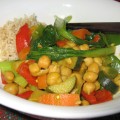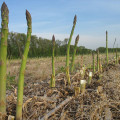
Traditional, staple foods from Asia, central South America, New Zealand, Australia and many more continents have made their way to American tables for some time, and if one surveys the grocery, natural food, and even big box store aisles one can see that they are here to stay. Even though thirty years ago Asian foods like tofu, soymilk, and shiitake mushrooms were novelties reserved for hard-core ‘foodies’, these foods have been enthusiastically embraced by the public and are considered commonplace.
Now there is a new “kid” on the block! Konjac is another traditional staple being introduced as an ingredient with amazing versatility and health benefits. Konjac, pronounced ‘kon-jack’, is also known as konjaku, konnyaku, and elephant yam. It is native to warm, sub tropical countries like Southeast Asia and Indonesia where it has been used for thousands of years as an everyday food. It is extremely popular in traditional Japanese cuisine where most of us have enjoyed it as oden or shirataki noodles, as well as a dessert. Where It is often used as a vegan substitute for conventional, animal-based gelatin.
In the US, Konjac is being introduced to consumers in products like weight loss supplements, (Konjac has almost no calories, but is very high in dietary fiber!), and even in a facial cleansing sponge. Konjac holds the flavor of other spices, herbs, and ingredients very well, so vegan visionaries are able to create amazingly innovative products with it. So, the most exciting development is its use in food like noodles and vegan seafood alternatives.
The Konjac plant is known for its large, starchy corms used for texture, and not its mild flavor. The dried corm of the Konjac plant is about 40% polysaccharide which makes it viscous and imparts a gelatin-like affect. It gives a satiety sensation, and has been studied as an ingredient that may mitigate the transport of cholesterol, and may also be an effective hypoglycemic and hypo-insulinemic agent.
Just like tofu and soymilk, konjac will find its way onto the consumers’ plate more and more often as vegan visionaries look to traditional staples for nutrition, versatility, texture, and health!

Vegan Seafood is not a paradox: it is now part of the vegan revolution! Sophie’s Kitchen Vegan Seafood is for those who love plant-based foods, vegans, vegetarians, and those with seafood allergies. The company has 20 years+ experience in creating vegetarian foods that now feature products made from konjac and mineral-rich seaweed.
Sophie is Eugene Wang’s, the company’s vegan visionary, first child. She liked all kinds of seafood, yet her extreme allergic reaction to it scared the family. They soon learned that they were not alone: a 2009-2010 study by the American Academy of Pediatrics found that 1 in 12 children have a food allergy, twice as many as previously thought.
Sustainability: Eugene was also alarmed that he could not find live jelly fish when visiting a beach that was famous for the unique creatures 30 years ago. He wanted to show them to Sophie. Now he wonders how many other species she will never see. The plant-based products are alternatives to dwindling seafood sources from the ocean, and the dangers of farm-raised seafood.
Enjoy seven, delicious vegan products: Vegan Shrimp, Vegan Prawns; Breaded Vegan: Calamari, Shrimp, Fish Fillets, Scallops, and Crab Cakes are coming soon. Most varieties are gluten-free and Non-GMO. No added sugar.
http://www.facebook.com/Sophies.Kitchen.vegan.products
https://twitter.com/VeganSeafood
https://www.youtube.com/watch?v=XeXE_l9QZp8
– “This Can’t Be Vegan – Szechwan Shrimp recipe”
Download Coupon:

http://www.sophieskitchen.net/swf/WebsiteCoupon.pdf






1 Comment
Chia (324 comments)
October 12, 2012 at 10:16 amI just bought the breaded vegan fish fillets, which come in large pieces. I ate an entire fillet with dinner and thought it was too much for one, so share it or save half for another time.
The fillet was well-seasoned and had a slightly chewy texture that I liked. I imagine it would taste great with tartar sauce like in fish n’ chips.